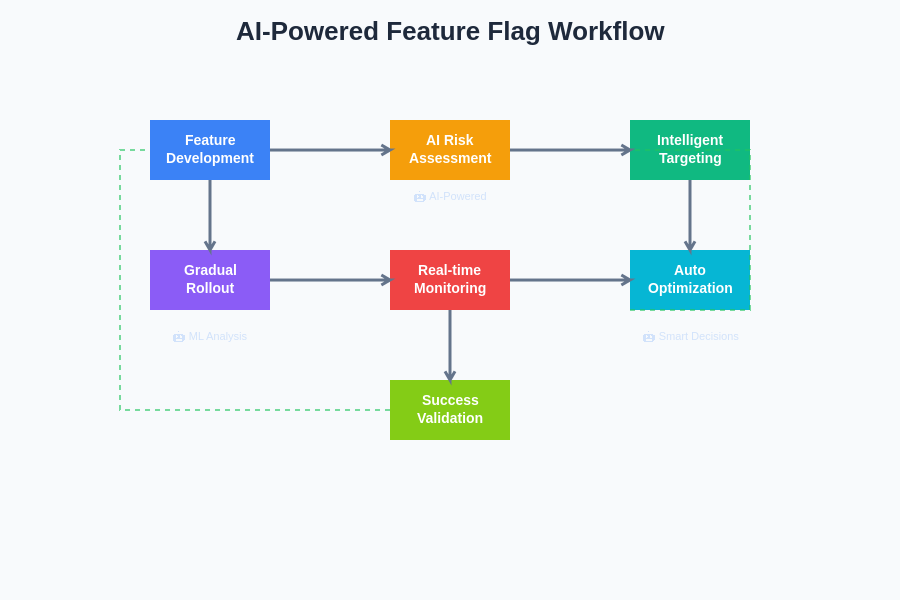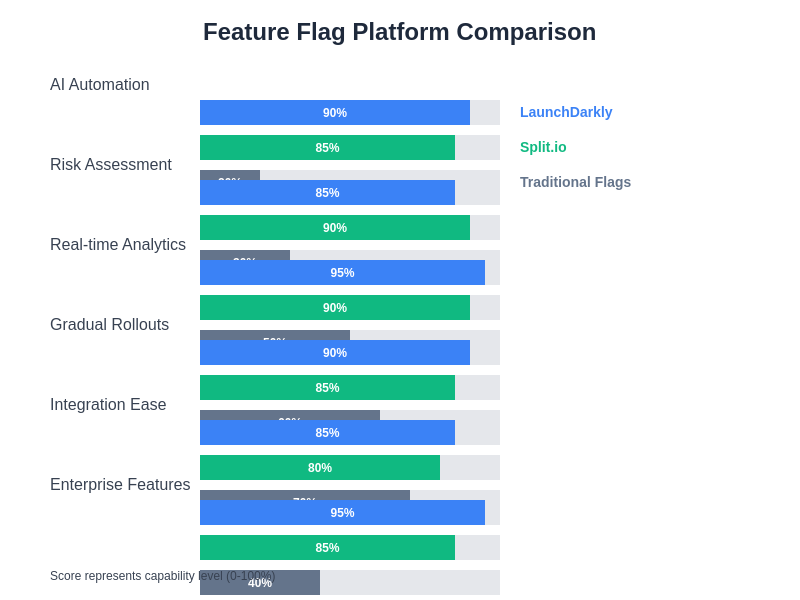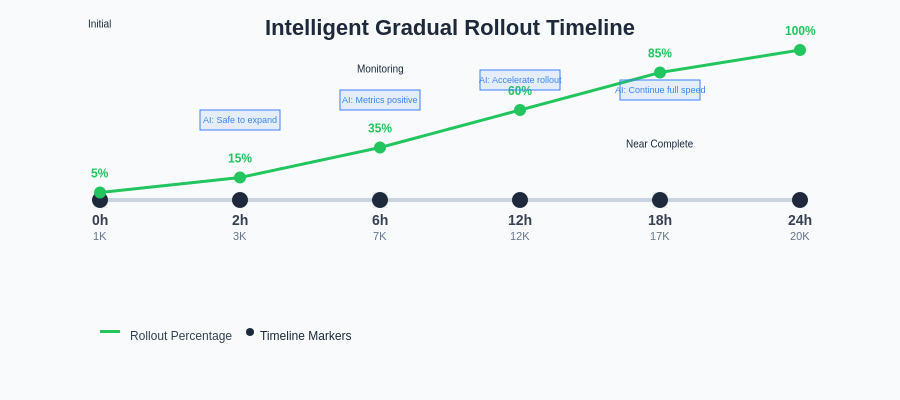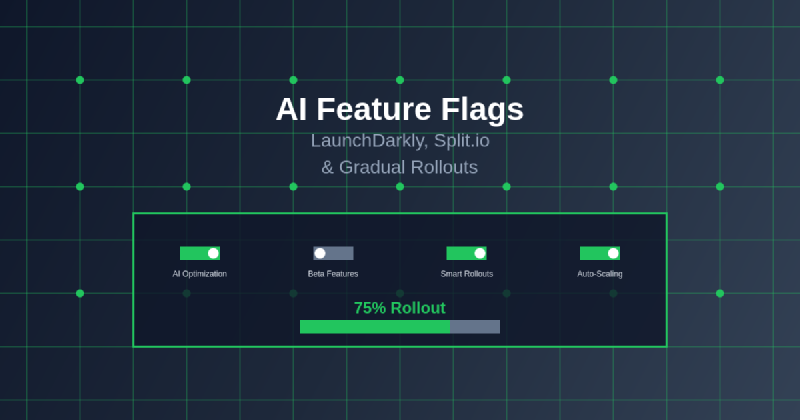The evolution of software deployment has reached a critical juncture where artificial intelligence intersects with feature flag management, creating unprecedented opportunities for intelligent, risk-aware, and data-driven rollout strategies. Modern platforms like LaunchDarkly and Split.io have embraced AI technologies to transform how development teams manage feature releases, moving beyond simple boolean switches to sophisticated systems that can predict user behavior, automatically adjust rollout percentages, and make real-time decisions based on performance metrics and user engagement patterns.
Discover the latest AI development trends that are shaping the future of intelligent deployment strategies and automated feature management systems. The integration of machine learning algorithms into feature flag platforms represents a fundamental shift from reactive deployment strategies to proactive, intelligent systems that can anticipate potential issues and optimize user experiences before problems manifest in production environments.
The Intelligence Revolution in Feature Flag Management
Traditional feature flags operated as simple on-off switches, providing basic segmentation and rollout capabilities that required manual intervention and constant monitoring. The integration of artificial intelligence has transformed these basic tools into sophisticated decision-making systems capable of analyzing vast amounts of user data, performance metrics, and business objectives to make autonomous deployment decisions that maximize positive outcomes while minimizing potential risks and negative impacts on user experience.
AI-powered feature flags leverage machine learning algorithms to identify patterns in user behavior, predict the likelihood of successful feature adoption, and automatically adjust rollout strategies based on real-time feedback from production systems. This intelligence enables development teams to deploy features with confidence, knowing that the system will continuously monitor performance indicators and make adjustments to ensure optimal outcomes for both users and business objectives.
The sophistication of modern AI-driven feature flag systems extends beyond simple statistical analysis to incorporate advanced predictive modeling, anomaly detection, and contextual understanding that considers factors such as user demographics, usage patterns, device characteristics, and temporal considerations that might influence feature adoption and success rates.

The comprehensive workflow demonstrates how artificial intelligence transforms every stage of feature deployment, from initial development through final validation, creating a seamless integration of human oversight with automated decision-making processes that ensure optimal outcomes while minimizing operational risks.
LaunchDarkly’s AI-Enhanced Deployment Intelligence
LaunchDarkly has positioned itself at the forefront of AI-powered feature flag management by integrating machine learning capabilities that enable intelligent automation of rollout strategies and risk assessment. The platform’s AI systems continuously analyze feature performance data, user engagement metrics, and system health indicators to provide recommendations for rollout optimization and automatic adjustment of feature flag configurations based on predefined success criteria and risk thresholds.
The platform’s intelligent targeting capabilities leverage user behavior analysis and predictive modeling to identify optimal user segments for feature rollouts, ensuring that new functionality is initially exposed to users who are most likely to provide positive feedback and successful adoption patterns. This targeted approach reduces the risk of negative user experiences while maximizing the potential for gathering valuable feedback and performance data during the early stages of feature deployment.
LaunchDarkly’s AI-driven anomaly detection systems monitor feature performance in real-time, automatically identifying unusual patterns in user behavior, system performance, or business metrics that might indicate potential issues with newly deployed features. When anomalies are detected, the system can automatically trigger rollback procedures or adjust rollout percentages to minimize negative impact while allowing development teams to investigate and address underlying issues.
Experience advanced AI capabilities with Claude for intelligent code analysis and feature development that integrates seamlessly with modern deployment platforms. The synergy between AI-powered development tools and intelligent feature flag management creates a comprehensive ecosystem for safe, efficient, and data-driven software delivery that minimizes risks while maximizing innovation opportunities.
Split.io’s Machine Learning Approach to Feature Optimization
Split.io has developed a sophisticated machine learning platform that goes beyond traditional feature flag management to provide comprehensive feature delivery and experimentation capabilities powered by artificial intelligence. The platform’s AI systems analyze user interactions, conversion rates, and business metrics to automatically optimize feature configurations and provide intelligent recommendations for feature improvements and rollout strategies.
The platform’s predictive analytics capabilities enable development teams to forecast the potential impact of feature changes before full deployment, using historical data and user behavior patterns to model likely outcomes and identify potential risks or opportunities. This predictive approach allows teams to make informed decisions about feature rollout strategies and resource allocation while minimizing the uncertainty traditionally associated with software deployments.
Split.io’s intelligent experimentation framework automatically designs and executes A/B tests and multivariate experiments, using machine learning algorithms to determine optimal sample sizes, identify statistically significant results, and provide actionable insights for feature improvement. The system continuously learns from experimental outcomes to improve future predictions and recommendations, creating a self-improving cycle of deployment intelligence.

The comparative analysis reveals significant differences in AI capabilities between modern feature flag platforms and traditional approaches, with advanced platforms like LaunchDarkly and Split.io demonstrating superior performance across critical metrics including automation, risk assessment, and real-time analytics capabilities.
Intelligent Gradual Rollout Strategies
The concept of gradual rollouts has been revolutionized through the application of artificial intelligence, transforming static percentage-based deployments into dynamic, adaptive systems that respond to real-time feedback and automatically adjust rollout velocity based on performance indicators and risk assessments. AI-powered gradual rollouts can accelerate successful deployments while slowing or halting problematic ones, ensuring that feature releases achieve maximum positive impact while minimizing potential negative consequences.
Modern AI systems analyze multiple data streams simultaneously, including user engagement metrics, system performance indicators, error rates, conversion statistics, and business KPIs to make intelligent decisions about rollout progression. These systems can identify subtle patterns and correlations that human operators might miss, enabling more nuanced and effective rollout strategies that balance speed with safety and user satisfaction with business objectives.
The intelligence embedded in modern rollout systems extends to user segmentation and targeting, where machine learning algorithms identify optimal user cohorts for progressive feature exposure based on factors such as engagement history, feature adoption patterns, risk tolerance, and potential business value. This intelligent targeting ensures that features reach the most receptive audiences first, building momentum and positive feedback before broader deployment.

The visualization demonstrates how AI-driven rollout systems make autonomous decisions throughout the deployment timeline, automatically adjusting rollout percentages based on real-time performance data, user feedback, and predictive analytics to ensure optimal feature adoption while maintaining system stability and user satisfaction.
Risk Mitigation Through Predictive Analytics
AI-powered feature flag platforms excel at risk mitigation through sophisticated predictive analytics that can forecast potential issues before they manifest in production environments. These systems analyze historical deployment data, user behavior patterns, and system performance metrics to identify risk factors and predict the likelihood of successful feature adoption or potential problems that might arise during rollout processes.
Machine learning algorithms continuously refine risk assessment models based on outcomes from previous deployments, creating increasingly accurate predictions about feature performance and user reception. This predictive capability enables development teams to proactively address potential issues, adjust rollout strategies, or implement additional safeguards before problems impact user experiences or business operations.
The integration of real-time monitoring with predictive analytics creates a comprehensive risk management system that can detect emerging issues in their earliest stages and automatically implement corrective actions such as rollback procedures, traffic redirection, or feature configuration adjustments. This proactive approach to risk management significantly reduces the potential for major incidents while enabling more aggressive innovation and faster deployment cycles.
Enhance your research and development capabilities with Perplexity to stay informed about emerging trends and best practices in AI-driven deployment strategies. The rapidly evolving landscape of intelligent feature management requires continuous learning and adaptation to leverage the latest advances in machine learning and deployment automation.
Automated Decision Making and Autonomous Deployments
The ultimate goal of AI-powered feature flag systems is the achievement of truly autonomous deployments that require minimal human intervention while maintaining high standards of safety and user satisfaction. Advanced machine learning algorithms can make complex deployment decisions based on comprehensive analysis of multiple data sources, automatically progressing successful rollouts while implementing protective measures for problematic deployments.
Autonomous deployment systems incorporate sophisticated decision trees and rule engines that can evaluate multiple scenarios and outcomes, selecting optimal strategies based on current conditions, historical performance, and predicted outcomes. These systems can handle complex deployment scenarios involving multiple features, interdependent systems, and diverse user populations while maintaining coherent and effective rollout strategies.
The development of autonomous deployment capabilities represents a significant advancement in software delivery practices, enabling development teams to focus on feature development and innovation while AI systems handle the complexities of safe, efficient deployment management. This automation reduces human error, accelerates deployment cycles, and ensures consistent application of best practices across all feature releases.
Performance Optimization Through Continuous Learning
AI-powered feature flag platforms continuously learn from deployment outcomes, user feedback, and system performance data to optimize future rollout strategies and improve overall platform effectiveness. Machine learning algorithms analyze patterns in successful and unsuccessful deployments to identify factors that contribute to positive outcomes and develop strategies for replicating success while avoiding known pitfalls.
The continuous learning capabilities of these systems enable increasingly sophisticated optimization strategies that consider complex interactions between features, user segments, and environmental factors that influence deployment success. Over time, these systems develop deep understanding of user behavior patterns, system capabilities, and business objectives that enable more effective and efficient deployment strategies.
Performance optimization extends beyond individual feature deployments to encompass overall platform efficiency, resource utilization, and user experience optimization. AI systems can identify opportunities for improvement across the entire deployment pipeline, suggesting infrastructure enhancements, process improvements, and strategic adjustments that enhance overall system performance and user satisfaction.
Integration with DevOps and CI/CD Pipelines
The integration of AI-powered feature flags with existing DevOps practices and continuous integration/continuous deployment pipelines creates comprehensive automation ecosystems that streamline the entire software delivery process. These integrated systems can automatically coordinate feature deployments with testing procedures, infrastructure provisioning, and monitoring systems to ensure seamless and efficient software delivery.
AI systems can optimize the timing and coordination of deployment activities, automatically scheduling rollouts during optimal time windows, coordinating with maintenance activities, and ensuring that adequate monitoring and support resources are available during critical deployment phases. This intelligent coordination reduces the complexity of deployment management while ensuring that all necessary safeguards and procedures are properly implemented.
The integration capabilities of modern AI-powered feature flag platforms extend to compatibility with diverse development tools, monitoring systems, and business intelligence platforms, creating unified ecosystems that provide comprehensive visibility and control over the entire software delivery process. This integration enables development teams to leverage existing investments in tools and processes while adding sophisticated AI capabilities that enhance overall effectiveness and efficiency.
Real-Time Analytics and Intelligent Monitoring
Advanced analytics capabilities integrated into AI-powered feature flag platforms provide real-time insights into feature performance, user behavior, and system health that enable informed decision-making and proactive issue resolution. These analytics systems process vast amounts of data in real-time, identifying trends, anomalies, and opportunities that might otherwise go unnoticed until significant impact has occurred.
Machine learning algorithms enhance traditional monitoring capabilities by identifying subtle patterns and correlations that indicate emerging issues or optimization opportunities. These intelligent monitoring systems can distinguish between normal variations in system behavior and genuine problems that require attention, reducing false alarms while ensuring that critical issues are quickly identified and addressed.
The real-time nature of AI-powered analytics enables immediate response to changing conditions, allowing deployment strategies to be adjusted dynamically based on current performance indicators and user feedback. This responsiveness ensures that rollout strategies remain optimal even as conditions change, maximizing the effectiveness of feature deployments while minimizing potential negative impacts.
Security and Compliance in AI-Driven Deployments
Security considerations become increasingly complex in AI-powered deployment environments, where automated systems make decisions that can impact system security, data privacy, and regulatory compliance. Modern AI-powered feature flag platforms incorporate sophisticated security frameworks that ensure deployment decisions comply with security policies, regulatory requirements, and organizational governance standards.
AI systems can automatically evaluate the security implications of feature deployments, identifying potential vulnerabilities, data exposure risks, and compliance issues before features reach production environments. These security assessments can trigger additional review processes, implement additional safeguards, or prevent deployments that pose unacceptable security risks.
The integration of compliance monitoring into AI-powered deployment systems ensures that feature rollouts maintain adherence to regulatory requirements such as GDPR, HIPAA, and industry-specific compliance standards. Automated compliance checking reduces the burden on development teams while ensuring that all deployments meet necessary regulatory and organizational requirements.
Future Evolution of Intelligent Feature Management
The future of AI-powered feature flag management promises even more sophisticated capabilities, including advanced predictive modeling, natural language interfaces for deployment management, and integration with emerging technologies such as quantum computing and edge computing environments. These advancements will further streamline deployment processes while providing unprecedented levels of intelligence and automation.
Emerging capabilities in natural language processing will enable developers to interact with deployment systems using conversational interfaces, describing desired outcomes and constraints in natural language while AI systems translate these requirements into optimal deployment strategies. This evolution will make sophisticated deployment capabilities accessible to broader development teams while reducing the complexity of configuration and management.
The integration of AI-powered feature flags with emerging architectural patterns such as microservices, serverless computing, and edge computing will create new opportunities for intelligent deployment strategies that can optimize performance, cost, and user experience across diverse and distributed computing environments. These advancements will enable more sophisticated and effective software delivery practices that support the growing complexity of modern application architectures.
The continued evolution of machine learning algorithms and predictive analytics will enable increasingly accurate forecasting of deployment outcomes, user behavior, and system performance, allowing development teams to make more informed decisions and implement more effective rollout strategies. This increased predictive accuracy will reduce risks associated with software deployments while enabling more aggressive innovation and faster time-to-market for new features and capabilities.
Disclaimer
This article is for informational purposes only and does not constitute professional advice. The views expressed are based on current understanding of AI technologies and their applications in feature flag management and software deployment. Readers should conduct their own research and consider their specific requirements when implementing AI-powered deployment tools. The effectiveness of AI-driven feature management may vary depending on specific use cases, organizational requirements, and technical environments. Organizations should carefully evaluate security, compliance, and operational implications before implementing autonomous deployment systems.
